The Reusable Nursing Pads Market is estimated to be valued at USD 4.3 billion in 2025 and is projected to reach USD 5.2 billion by 2035, registering a compound annual growth rate (CAGR) of 1.9% over the forecast period.
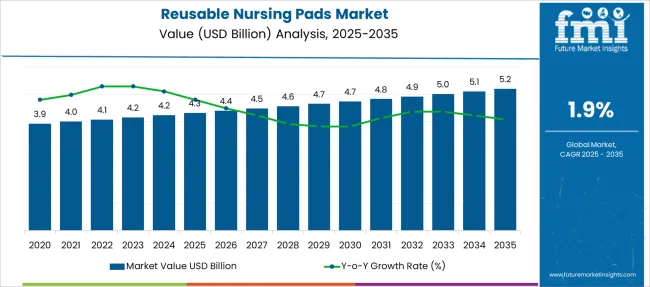
| Metric | Value |
|---|---|
| Reusable Nursing Pads Market Estimated Value in (2025 E) | USD 4.3 billion |
| Reusable Nursing Pads Market Forecast Value in (2035 F) | USD 5.2 billion |
| Forecast CAGR (2025 to 2035) | 1.9% |
The reusable nursing pads market is experiencing accelerated growth due to rising awareness around sustainable maternal care solutions and the growing inclination toward eco-friendly, washable alternatives to disposable hygiene products. This shift is being reinforced by increasing breastfeeding rates, public health campaigns promoting breastfeeding benefits, and growing environmental concerns among postpartum women. Reusable nursing pads are gaining traction particularly in developed markets where hygiene, comfort, and reusability are being prioritized over disposability.
Technological enhancements in fabric design, including leakproof and hypoallergenic materials, are making these products more comfortable and reliable. Additionally, affordability and long-term cost savings have made reusable nursing pads attractive across income groups.
The growing penetration of e-commerce platforms, social media advocacy, and consumer health forums are amplifying product visibility, enabling market expansion even in tier 2 and tier 3 geographies Over the coming years, the market is expected to benefit from increased product innovation, better fit customization, and rising demand for postpartum wellness solutions.
The market is segmented by Application, Price Range, and Sales Channels and region. By Application, the market is divided into Home and Hospital. In terms of Price Range, the market is classified into Low, Medium, and Premium. Based on Sales Channels, the market is segmented into Online and Offline. Regionally, the market is classified into North America, Latin America, Western Europe, Eastern Europe, Balkan & Baltic Countries, Russia & Belarus, Central Asia, East Asia, South Asia & Pacific, and the Middle East & Africa.
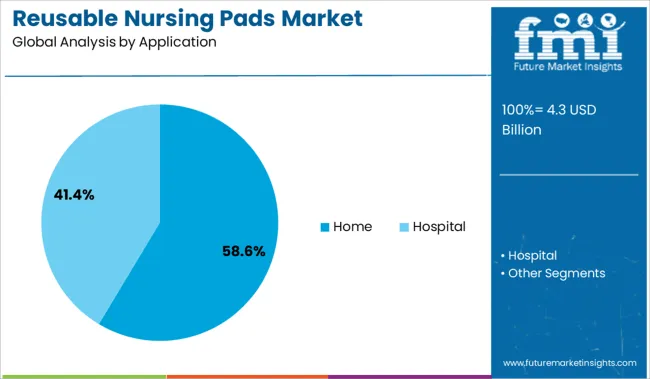
The home application segment is expected to account for 58.6% of the reusable nursing pads market revenue share in 2025, establishing it as the most dominant application area. This segment’s leadership is being driven by the increasing tendency of new mothers to breastfeed within the comfort and privacy of their homes.
The convenience of using reusable nursing pads at home, combined with the ability to wash and reuse them multiple times, has significantly enhanced user adoption. Improvements in fabric technology, such as breathable cotton blends and antimicrobial layers, have contributed to extended daily wear without discomfort, which is particularly beneficial in a home setting.
Additionally, health advisories and maternity counselors increasingly promote home breastfeeding, aligning with hygienic and low-waste practices The cost-effectiveness of at-home usage also reduces the need for frequent product replacement, making reusable nursing pads a practical and sustainable choice for postpartum mothers.
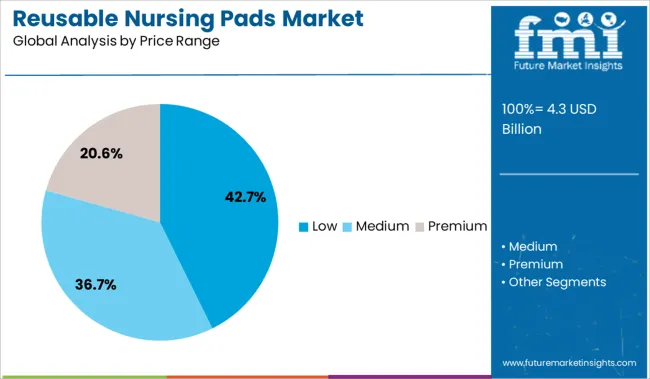
The low price range segment is projected to hold 42.7% of the reusable nursing pads market share in 2025, making it the leading price category. The segment’s growth is being driven by increasing demand among cost-sensitive consumers seeking affordable yet effective maternal care solutions.
The affordability of reusable nursing pads within this price bracket has widened accessibility across diverse economic backgrounds, particularly in emerging economies where discretionary spending remains cautious. Enhanced distribution by direct-to-consumer brands and bulk packaging options have contributed to value-based pricing without compromising on comfort or absorption quality.
The availability of economically priced nursing pads with core protective features has enabled broader adoption, especially among first-time mothers and younger demographics Manufacturers are also responding with budget-friendly packs that retain core usability and hygiene features, thus strengthening this segment’s appeal in competitive retail landscapes.
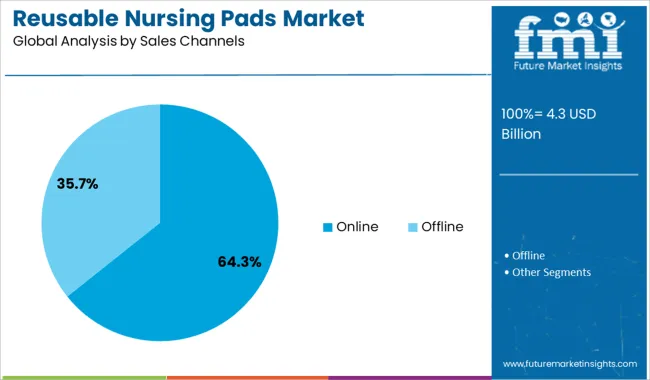
The online sales channel segment is expected to contribute 64.3% of the overall reusable nursing pads market revenue in 2025, emerging as the most significant distribution route. This dominance is being attributed to the widespread expansion of e-commerce platforms, direct-to-consumer maternity care brands, and digital marketplaces focused on maternal wellness products. Online retail has allowed new mothers to conveniently explore product options, compare features, and read peer reviews from the comfort of their homes.
Increased participation in parenting forums and influencer-led brand endorsements have further accelerated product discovery and trust through digital touchpoints. The convenience of subscription models and bundled offers has enhanced recurring purchase behavior through online platforms.
Furthermore, logistical advancements and hyperlocal delivery models have improved access to nursing care essentials even in non-metropolitan areas As digital literacy and mobile commerce continue to grow, the online sales channel is poised to remain the dominant mode of distribution for reusable nursing pads globally.
The rising popularity of nursing pads across the world is escalating the reusable nursing pads market growth.
The reusable nursing pads market is driven due to its increasing awareness regarding the usage and characteristics of nursing pads and the demand for reusable nursing pads across the globe.
The reusable nursing pads market is gaining traction, especially in developing regions where consumers are progressively favoring the product. Leakage of breast milk is one of the major problems which are faced by mothers, which increases demand for reusable nursing pads as well as sales of reusable nursing pads.
Reusable nursing pad markets have become a beneficial product approach for consumers to prevent the leaking of milk. The reusable nursing pads market has been one of the high-growth markets under breastfeeding products for the past few years, as it continues to reach out to new consumers every day.
The growing e-commerce platform in emerging economies is also one of the beneficial aspects of the growth of the reusable nursing pads market, along with the demand for reusable nursing pads. The rise in internet penetration is playing a vital role in growing awareness of the demand for reusable nursing pads. This led to the growth in the sale of reusable nursing pads across the inline platform.
The highest quality standards offered by the manufacturers of the reusable nursing pads market are also among the driving factor which is influencing the consumer regarding the buying of reusable nursing pads, resulting in escalated sales of reusable nursing pads.
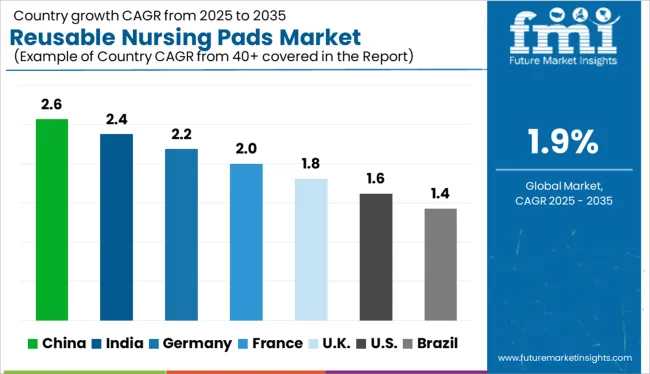
Since the use of safe and high-quality pregnancy accessories is growing in the regions such as East Asia, South Asia, and the Middle East & African countries, the reusable nursing pads market participants will be getting a beneficial opportunity in the global reusable nursing pads market during the forecast period.
The growing acceptance of reusable nursing pads at a higher rate could boost the demand for reusable nursing pads, mostly in developing countries. This offers a better market scenario to the manufacturers in the global reusable nursing pads market.
However, South and East Asia are anticipated to exhibit the highest growth in the global reusable nursing pads market due to growing awareness regarding products among the middle-class population of these two regions surging the demand for reusable nursing pads together with sales of reusable nursing pads.
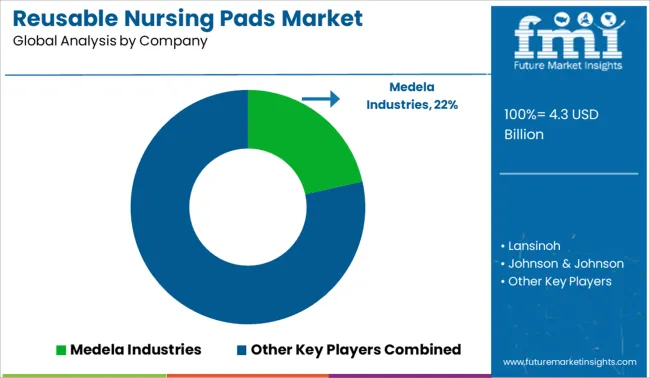
The reusable nursing pads market is fragmented, and this trend will continue over the projected period. Some of the main market participants are Medela Industries, Lansinoh, Johnson & Johnson, Bamboobies, Lily Padz, Kindred Bravely, Eco Nursing Pads, Mother Ease, Pigeon, and Ameda.
Reusable nursing pads market suppliers should focus more on the growth possibilities and boost sales of reusable nursing pads in the fast-growing sectors while preserving their positions in the slow-growing segments to capitalize on the potential.
| Report Attribute | Details |
|---|---|
| Growth rate | CAGR of 1.9% from 2025 to 2035 |
| The base year for estimation | 2024 |
| Historical data | 2020 to 2024 |
| Forecast period | 2025 to 2035 |
| Quantitative units | Revenue in USD billion, volume in kilotons, and CAGR from 2025 to 2035 |
| Report Coverage | Revenue forecast, volume forecast, company ranking, competitive landscape, growth factors, and trends, Pricing Analysis |
| Segments Covered | Nature, Fabric Type, Sales Channel, region |
| Regional scope | North America; Western Europe; Eastern Europe; Middle East; Africa; ASEAN; South Asia; Rest of Asia; Australia; and New Zealand |
| Country scope | USA, Canada, Mexico, Germany, United Kingdom, France, Italy, Spain, Russia, Belgium, Poland, Czech Republic, China, India, Japan, Australia, Brazil, Argentina, Colombia, Saudi Arabia, United Arab Emirates(UAE), Iran, South Africa |
| Key companies profiled | Medela Industries; Lansinoh; Johnson & Johnson; Bamboobies; Lily Padz; Kindred Bravely; Eco Nursing Pads; Mother Ease; Pigeon; and Ameda |
| Customization scope | Free report customization (equivalent to up to 8 analysts’ working days) with purchase. Addition or alteration to country, regional & segment scope. |
| Pricing and purchase options | Avail customized purchase options to meet your exact research needs. |
The global reusable nursing pads market is estimated to be valued at USD 4.3 billion in 2025.
The market size for the reusable nursing pads market is projected to reach USD 5.2 billion by 2035.
The reusable nursing pads market is expected to grow at a 1.9% CAGR between 2025 and 2035.
The key product types in reusable nursing pads market are home and hospital.
In terms of price range, low segment to command 42.7% share in the reusable nursing pads market in 2025.






Our Research Products

The "Full Research Suite" delivers actionable market intel, deep dives on markets or technologies, so clients act faster, cut risk, and unlock growth.

The Leaderboard benchmarks and ranks top vendors, classifying them as Established Leaders, Leading Challengers, or Disruptors & Challengers.

Locates where complements amplify value and substitutes erode it, forecasting net impact by horizon

We deliver granular, decision-grade intel: market sizing, 5-year forecasts, pricing, adoption, usage, revenue, and operational KPIs—plus competitor tracking, regulation, and value chains—across 60 countries broadly.

Spot the shifts before they hit your P&L. We track inflection points, adoption curves, pricing moves, and ecosystem plays to show where demand is heading, why it is changing, and what to do next across high-growth markets and disruptive tech

Real-time reads of user behavior. We track shifting priorities, perceptions of today’s and next-gen services, and provider experience, then pace how fast tech moves from trial to adoption, blending buyer, consumer, and channel inputs with social signals (#WhySwitch, #UX).

Partner with our analyst team to build a custom report designed around your business priorities. From analysing market trends to assessing competitors or crafting bespoke datasets, we tailor insights to your needs.
Supplier Intelligence
Discovery & Profiling
Capacity & Footprint
Performance & Risk
Compliance & Governance
Commercial Readiness
Who Supplies Whom
Scorecards & Shortlists
Playbooks & Docs
Category Intelligence
Definition & Scope
Demand & Use Cases
Cost Drivers
Market Structure
Supply Chain Map
Trade & Policy
Operating Norms
Deliverables
Buyer Intelligence
Account Basics
Spend & Scope
Procurement Model
Vendor Requirements
Terms & Policies
Entry Strategy
Pain Points & Triggers
Outputs
Pricing Analysis
Benchmarks
Trends
Should-Cost
Indexation
Landed Cost
Commercial Terms
Deliverables
Brand Analysis
Positioning & Value Prop
Share & Presence
Customer Evidence
Go-to-Market
Digital & Reputation
Compliance & Trust
KPIs & Gaps
Outputs
Full Research Suite comprises of:
Market outlook & trends analysis
Interviews & case studies
Strategic recommendations
Vendor profiles & capabilities analysis
5-year forecasts
8 regions and 60+ country-level data splits
Market segment data splits
12 months of continuous data updates
DELIVERED AS:
PDF EXCEL ONLINE
Reusable Sanitary Pads Market Growth - Size, Demand & Forecast 2025 to 2035
Reusable Water Bottle Market Forecast and Outlook 2025 to 2035
Reusable Box Market Forecast and Outlook 2025 to 2035
Reusable Crate Welding Lines Market Size and Share Forecast Outlook 2025 to 2035
Reusable Transport Packs Market Size and Share Forecast Outlook 2025 to 2035
Reusable Oil Absorbents Market Size and Share Forecast Outlook 2025 to 2035
Reusable Grocery Tote Market Analysis - Size and Share Forecast Outlook 2025 to 2035
Reusable Period Panties Market Analysis - Size, Share, and Forecast Outlook 2025 to 2035
Reusable Tumblers Market Size and Share Forecast Outlook 2025 to 2035
Reusable Laparoscopic Instruments Market is segmented by Reusable Laparoscopic Scissors and Reusable Hand Instruments from 2025 to 2035
Reusable Incontinence Products Market Analysis - Size, Share & Forecast 2025 to 2035
Reusable Cold Chain Packaging Market Size and Share Forecast Outlook 2025 to 2035
Reusable Wine Bags Market Size and Share Forecast Outlook 2025 to 2035
Reusable Packing Market Size, Share & Forecast 2025 to 2035
Reusable Straws Market Analysis - Trends, Growth & Forecast 2025 to 2035
Reusable Egg Containers Market Trends – Growth & Forecast 2025 to 2035
A Detailed Global Analysis of Brand Share for the Reusable Incontinence Products Market
A Detailed Global Analysis of Brand Share for the Reusable Period Panties Market
Industry Share Analysis for Reusable Wine Bags Companies
Evaluating Reusable Cold Chain Packaging Market Share & Provider Insights

Thank you!
You will receive an email from our Business Development Manager. Please be sure to check your SPAM/JUNK folder too.
Chat With
MaRIA